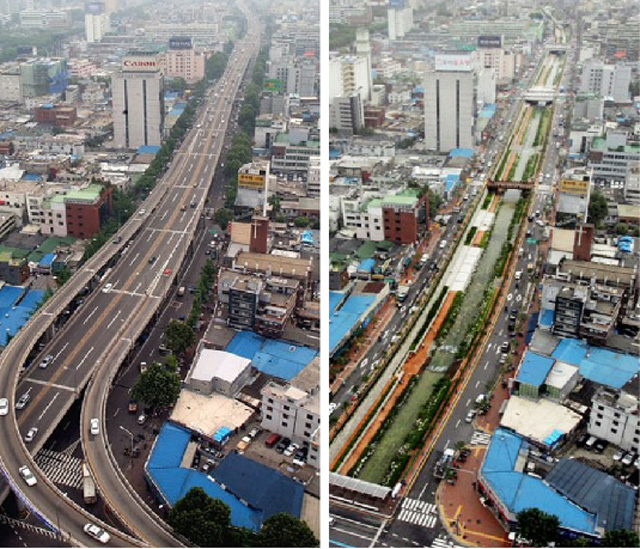Context
- Located in South Seoul in South Korea, Cheonggyecheon has a population of over 10 million people. It is one of the most densely populated cities in South Korea with over 17,000 per square kilometre.
- The Cheonggyecheon river stream became overcrowded and blighted by traffic.
- Dredging of the stream started in 1918, due to its sanitation and flood risk. WW2 and the Korean War halted the construction until 1958, the stream finally covered in 1961.
- A 4 way overpass was built in 1971
- In 2003, an ambitious 2 year $281 million restoration scheme was launched

Aims
- To value quality of life of South Korean’s citizens and the importance of functioning ecosystems
- The ageing elevated freeway and concrete deck covering the Cheonggyecheon stream posed safety risks
- Improved the connectivity of the north and south of the city, which the freeway divided.
- Areas next to the freeway housed over 100,000 small businesses. The overpass had seriously impacted their businesses and by the end of the 20th century the area was polluted and run down with little green space.
- Recreational and ecological opportunities along a 5.8km corridor in the centre of Seoul
Work Carried Out
- The freeway and concrete deck covering the stream were dismantled
- 22 bridges (12 pedestrian, 10 for cars and pedestrians) were built to improve movement from the south – north of the city
- Car use was discouraged in the area, rapid bus lanes were added and the improved loading and unloading systems were implemented
- Water from the nearby Hanang River is pumped to the area to create a consistent flow with an average depth of 40cm.
- The annual Lantern Festival is held along the river (pretty pictures)
- The corridor runs from Seoul to an ecological conservation area outside of the city, and is split into three zones which mark the transition from an urban landscape to a natural environment.
- Central Historic Zone: Area for the public to use. Decorated river banks and history facts along the river make the area a pleasant place to walk through.
- Middle Zone: Recreation areas, waterfront decks and stepping stones. Fountains and waterfalls. Very decorated
- Final Zone: Designed to look overgrown and untamed. Sections of the pier and overpass were left as industrial mementos.

Attitudes
- South Korean president, Lee Myung Bak included the restoration of the stream in his successful bid to become the Mayor of Seoul in 2001 and it became the priority for his administration.
- Transportation experts were concerned that the removal of the elevated highway would cause traffic congestion due to the high volume of traffic the road carried (169,000 cars per day)
- The Cheonggyecheon Restoration Citizen’s Committee of professional and citizen groups took responsibility for gauging public opinion, communicating the project’s goals.
- Local businesses saw the restoration project as a threat to their livelihoods. The Citizen’s Committee surveyed the market and held regular consultation meetings.
- The Seoul Metropolitan Authority provided a range of services to stimulate business activity:
- Extra parking
- Reduced parking fees
- Improved loading and unloading systems
- Promoted Cheonggyecheon businesses
- Provided support, subsidies and grants for business restructuring
- Special arrangements for businesses relocating
Evaluation
- The restoration has become a tourist attraction, drawing around 18.1 million visitors by the end of 2008.
- Encouraged diversity through public facilities, such as the Dongdaemun plaza
Economic Sustainability 🤑
- Since the start of the project the area has fallen behind the rest of Seoul in terms of economic viability
- Development capital has been invested into residential construction. Housing prices are double rate in comparison to anywhere else in Seoul
- The number of businesses is almost equal to before the restoration project
Traffic 🚗
- Speeds in the central business district has reduced by 12.3%
- Use of bus and subway has increased
- Removal of large numbers of cars have created a 2.5°C decrease in annual temperatures
Environment 🌲
- The restoration of the stream has re-established lost habitats, plant and animal species have reappeared – an urban wildlife haven
Inclusive Design 📐
- Limited consideration for certain user groups, e.g older people, people with visual impairments and people with mobility problems.
- In September 2005 a group led a protest march demanding the right to access the new pathways alongside the stream.
- In response, lifts were provided at seven locations, together with free wheelchairs for users with mobility problems.
Further Reading
